Meteorological Drought Assessment and Trend Analysis in Puntland Region of Somalia
Abstract
1. Introduction
- (i)
- This is a problem-oriented study aiming at providing insights for the decision-makers in the region to have a clear picture of the drought risk and allow them to take preventative steps. More than three decades of civil war in Somalia have resulted in the non-institutionalized governance to inform historical drought conditions in the country.
- (ii)
- This study aims to investigate and assess the duration and severity of meteorological droughts using different meteorological indices due to no single index that can represent all aspects of meteorological drought. To this end, Percent of Normal Index (PNI), Deciles Index (DI), Standardized Precipitation Index (normal-SPI, gamma-SPI, log-SPI), and Discrepancy Precipitation Index (DPI) are utilized.
- (iii)
- This study aims to identify the annual precipitation and temperature trends during 1980–2020 in the Puntland region of Somalia. To the best knowledge of the authors, no comprehensive study has yet been conducted to investigate the trends and turn points events for the temperature and precipitation time series in Puntland region of Somalia in the literature. This study might give insights to the water resources planning in the region under climate change conditions.
2. Study Area
3. Methods
3.1. Drought Indices
3.1.1. Standardized Precipitation Index Methods
Normal-SPI
Log-SPI
Gamma-SPI
3.1.2. Percent of Normal Index (PNI)
3.1.3. Discrepancy Precipitation Index (DPI)
3.1.4. Deciles Index (DI)
3.2. Trend Test Methods
3.2.1. Spearman’s Rho Test
3.2.2. Mann–Kendall Test
3.2.3. Şen Test
3.2.4. Thiel-Sen Test
3.2.5. Pettitt’s Test
4. Results
4.1. Drought Analysis
4.1.1. Bossaso Station
4.1.2. Qardho Station
4.1.3. Garowe Station
4.2. Trend Analysis
4.2.1. Temperature Trend
4.2.2. Precipitation Trend
5. Discussion
6. Conclusions
- (1)
- A severe drought hit the entire East African region between July 2011 and mid-2012, described as the worst in the last 60 years. It had caused widespread devastation by triggering a catastrophic food crisis in Somalia, Djibouti, Ethiopia, and Kenya, threatening the livelihoods of 9.5 million people in those countries.
- (2)
- Somalia has gone through extended droughts over the previous 40 years, exacerbating the humanitarian situation.
- (3)
- Several severe droughts have occurred in recent years, including 1964, 1969, 1974, 1987, 1988, 2000, 2001, 2004, 2008, 2011, 2016, and 2017.
- (4)
- Severe drought is likely in Garowe, Bossaso, and Qardho stations when precipitation is less than 162 mm/year, 25 mm/year, and 220 mm/year, respectively.
- (5)
- For the drought analysis within the Puntland regions, drought indices produced nearly the same results.
- (6)
- The log-SPI and gamma-SPI produce similar results having CC values close to unity by predicting more severe drought conditions, whereas the normal-SPI gives more wet cases and fewer drought cases for all stations.
- (7)
- Normal-SPI, gamma-SPI, and PNI indicate less and moderate drought conditions, whereas log-SPI, DPI, and DI accurately captured the historical extreme and severe drought periods; thus, these methods are recommended for the use as drought assessment tools in this region.
- (8)
- Not only are the PNI and DPI less correlated to each other, but their CC with the SPI-based drought indices are also not as high as the SPI-based indices.
- (9)
- Drought monitoring and early warning are critical instruments for managing crop losses, preventing famines, and lowering the danger of famine. In Somalia, there is currently no national drought monitor in place. Therefore, determining the most appropriate meteorological drought index would help authorities to develop a drought monitoring system for states and the entire country. This technique can give decision-makers in the region a clear picture of the drought risk and allow them to take preventative steps. It is suggested that more research must be done to assess and evaluate meteorological drought indices across the country.
- (10)
- Temperature and precipitation data trend analysis shows positive trends in precipitation and temperature. Although all the stations are experiencing slight increases in precipitation and temperature, they differ in trend direction changes (slope and jumps).
- (11)
- The annual average temperatures in Qardho, Bossaso, and Garowe are found to increase by 0.2 °C, 0.3 °C, and 0.4 °C per decade.
- (12)
- The abrupt changes in annual temperatures (maximum, minimum, and average) are detected for all stations in 2000, indicating that the region experienced a significant shift in trend direction in that year.
- (13)
- The precipitation time series has a positive trend detected in Bossaso and Garowe stations (at the rate of 3.67 mm per year in Bossaso and 5.41 mm per year in Garowe), while no trend is detected in Qardho station.
Author Contributions
Funding
Institutional Review Board Statement
Conflicts of Interest
References
- Vaheddoost, B.; Safari, M.J.S. Application of signal processing in tracking meteorological drought in a mountainous region. Pure Appl. Geophys. 2021, 178, 1943–1957. [Google Scholar] [CrossRef]
- Mustafa, A.; Rahman, G. Assessing the spatio-temporal variability of meteorological Drought in Jordan. Earth Syst. Environ. 2018, 2, 247–264. [Google Scholar] [CrossRef]
- Mersin, D.; Gulmez, A.; Safari, M.J.S.; Vaheddoost, B.; Tayfur, G. Drought Assessment in the Aegean Region of Turkey. Pure Appl. Geophys 2022, 179, 3035–3053. [Google Scholar] [CrossRef]
- Said, A.A.; Cetin, M.; Yurtal, R. Drought assessment and monitoring using some drought indicators in the semi-arid Puntland State of Somalia. Fresenius Environ. Bull. 2019, 28, 8765–8772. [Google Scholar]
- Mehr, A.D.; Safari, M.J.S.; Nourani, V. Wavelet packet-genetic programming: A new model for meteorological drought hindcasting. Tek. Dergi 2021, 32, 11029–11050. [Google Scholar] [CrossRef]
- Mishra, A.K.; Singh, V.P. A review of drought concepts. J. Hydrol. 2010, 391, 202–216. [Google Scholar] [CrossRef]
- Haji-Aghajany, S.; Amerian, Y.; Amiri-Simkooei, A. Function-Based Troposphere Tomography Technique for Optimal Downscaling of Precipitation. Remote Sens. 2022, 14, 2548. [Google Scholar] [CrossRef]
- Haji-Aghajany, S.; Amerian, Y.; Amiri-Simkooei, A. Impact of Climate Change Parameters on Groundwater Level: Implications for Two Subsidence Regions in Iran Using Geodetic Observations and Artificial Neural Networks (ANN). Remote Sens. 2023, 15, 1555. [Google Scholar] [CrossRef]
- Wang, S.; Zhang, Q.; Wang, J.; Liu, Y.; Zhang, Y. Relationship between drought and precipitation heterogeneity: An analysis across rain-fed agricultural regions in eastern Gansu, China. Atmosphere 2021, 12, 1274. [Google Scholar] [CrossRef]
- Kew, S.F.; Philip, S.Y.; Hauser, M.; Hobbins, M.; Wanders, N.; van Oldenborgh, G.J.; Weil, K.; Veldkamp, T.I.E.; Kimutai, J.; Funk, C.; et al. Impact of precipitation and increasing temperatures on drought in eastern Africa. Earth Syst. Dyn. Discuss. 2019, 12, 17–35. [Google Scholar] [CrossRef]
- Maxwell, D.; Fitzpatrick, M. The 2011 Somalia famine: Context, causes, and complications. Glob. Food Secur. 2012, 1, 5–12. [Google Scholar] [CrossRef]
- Maystadt, J.F.; Ecker, O. Extreme weather and civil war: Does drought fuel conflict in Somalia through livestock price shocks? Am. J. Agric. Econ. 2014, 96, 1157–1182. [Google Scholar] [CrossRef]
- Shiau, J.T. Fitting drought duration and severity with two-dimensional copulas. Water Resour. Manag. 2006, 20, 795–815. [Google Scholar] [CrossRef]
- Tayfur, G. Discrepancy precipitation index for monitoring meteorological Drought. J. Hydrol. 2021, 597, 126174. [Google Scholar] [CrossRef]
- McKee, T.B.; Doesken, N.J.; Kleist, J. The relationship of drought frequency and duration to time scales. In Proceedings of the 8th Conference on Applied Climatology, Anaheim, CA, USA, 17–22 January 1993. [Google Scholar]
- Cacciamani, C.; Morgillo, A.; Marchesi, S.; Pavan, V. Monitoring and Forecasting Drought on a Regional Scale: Emilia-Romagna Region Methods and Tools for Drought Analysis and Management; Springer: Berlin/Heidelberg, Germany, 2007; pp. 29–48. [Google Scholar]
- Hayes, M.J. Drought Indices; Wiley Online Library: Hoboken, NJ, USA, 2006. [Google Scholar]
- Lloyd-Hughes, B.; Saunders, M.A. A drought climatology for Europe. Int. J. Climatol. 2002, 22, 1571–1592. [Google Scholar] [CrossRef]
- Angelidis, P.; Maris, F.; Kotsovinos, N.; Hrissanthou, V. Computation of drought index SPI with alternative distribution functions. Water Resour. Manag. 2012, 26, 2453–2473. [Google Scholar] [CrossRef]
- Gąsiorek, E.; Musiał, E. Evaluation of the Precision of Standardized Precipitation Index (SPI) Based on Years 1954–1995 in Łódź. J. Ecol. Eng. 2015, 16, 49–53. [Google Scholar] [CrossRef]
- Barua, S.; Ng, A.; Perera, B. Comparative evaluation of drought indexes: Case study on the Yarra River catchment in Australia. J. Water Resour. Plan. Manag. 2010, 137, 215–226. [Google Scholar] [CrossRef]
- Gibbs, W.J.; Maher, J.V. Rainfall Deciles as Drought Indicators; Bureau of Meteorology: Melbourne, Australia, 1967.
- Shadmani, M.; Marofi, S.; Roknian, M. Trend analysis in reference evapotranspiration using Mann-Kendall and Spearman’s Rho tests in arid regions of Iran. Water Resour. Manag. 2012, 26, 211–224. [Google Scholar] [CrossRef]
- Salas, J.D. Analysis and modelling of hydrologic time series. In Handbook of Hydrology; Maidment, D.R., Ed.; McGraw-Hill: New York, NY, USA, 1993. [Google Scholar]
- Sen, Z. Innovative trend analysis methodology. J. Hydrol. Eng. 2012, 17, 1042–1046. [Google Scholar] [CrossRef]
- Pettitt, A.N. A non-parametric approach to the change-point problem. J. R. Stat. Soc. Ser. C (Appl. Stat.) 1979, 28, 126–135. [Google Scholar] [CrossRef]
- Chen, S.-T.; Kuo, C.-C.; Yu, P.-S. Historical trends and variability of meteorological droughts in Taiwan. Hydrol. Sci. J. 2009, 54, 430–441. [Google Scholar] [CrossRef]
- Musei, S.K.; Nyaga, J.M.; Dubow, A.Z. SPEI-based spatial and temporal evaluation of drought in Somalia. J. Arid. Environ. 2021, 184, 104296. [Google Scholar] [CrossRef]
- Uhe, P.; Philip, S.; Kew, S.; Shah, K.; Kimutai, J.; Mwangi, E.; van Oldenborgh, G.J.; Singh, R.; Arrighi, J.; Jjemba, E.; et al. Attributing drivers of the 2016 Kenyan drought. Int. J. Climatol. 2018, 38, e554–e568. [Google Scholar] [CrossRef]
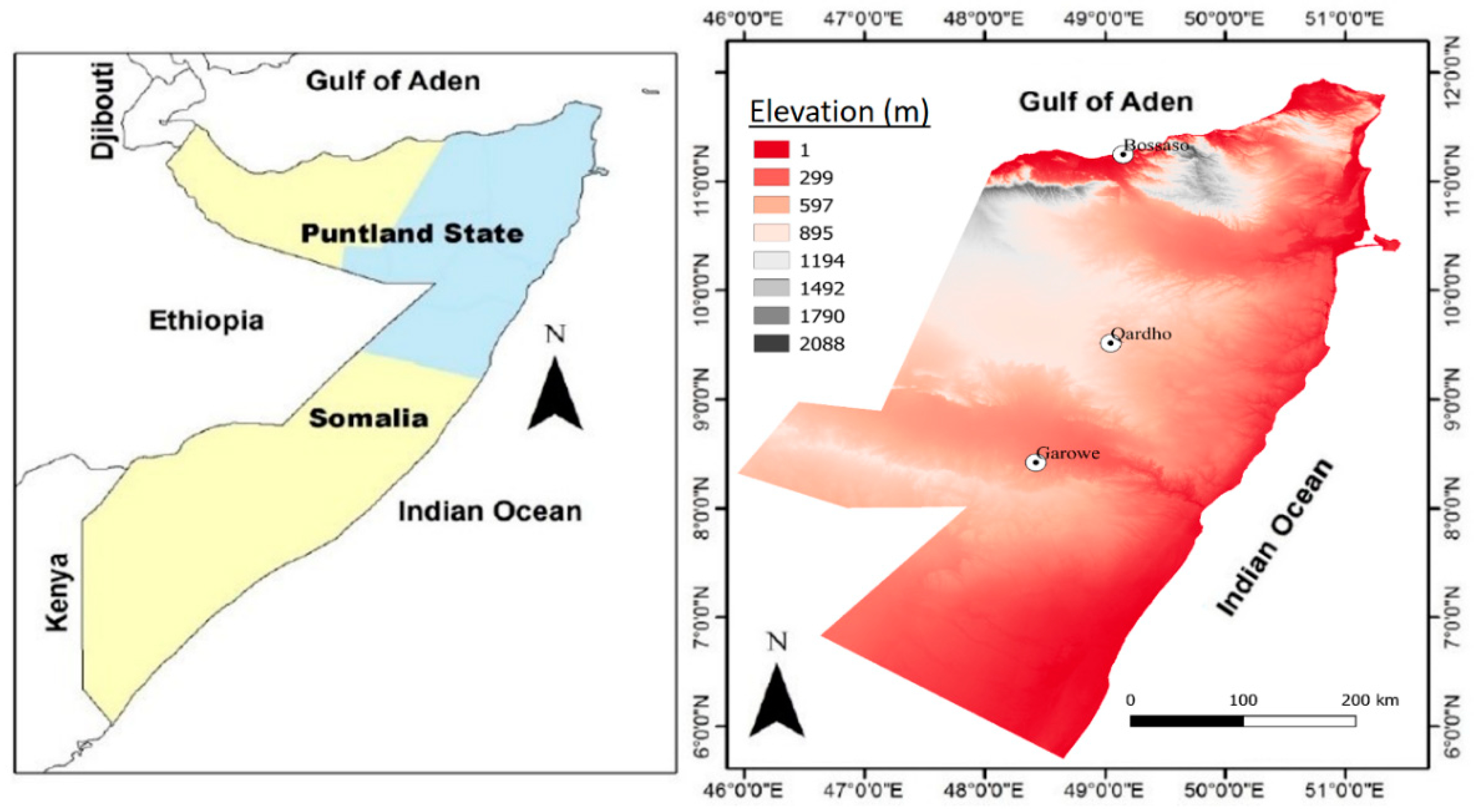


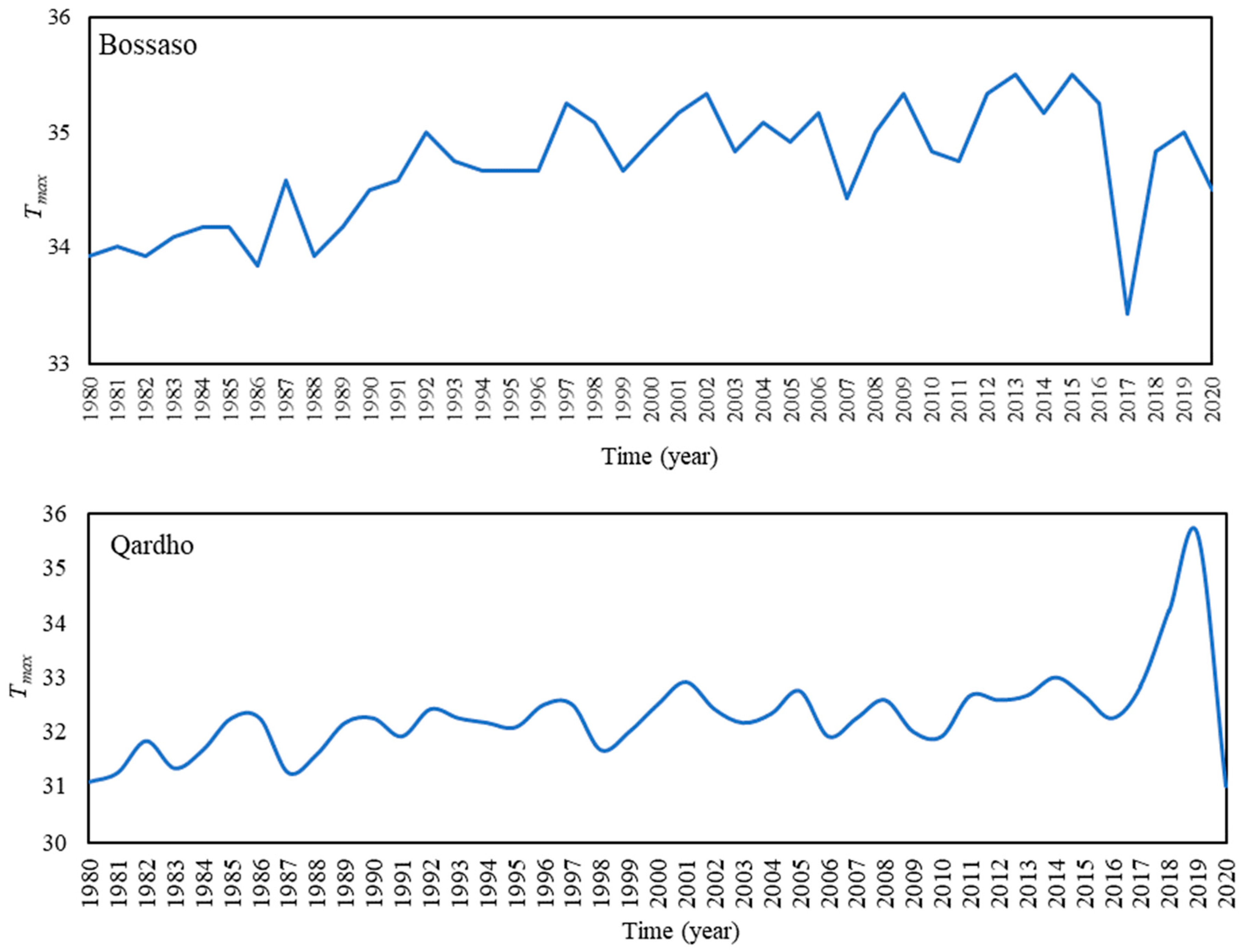
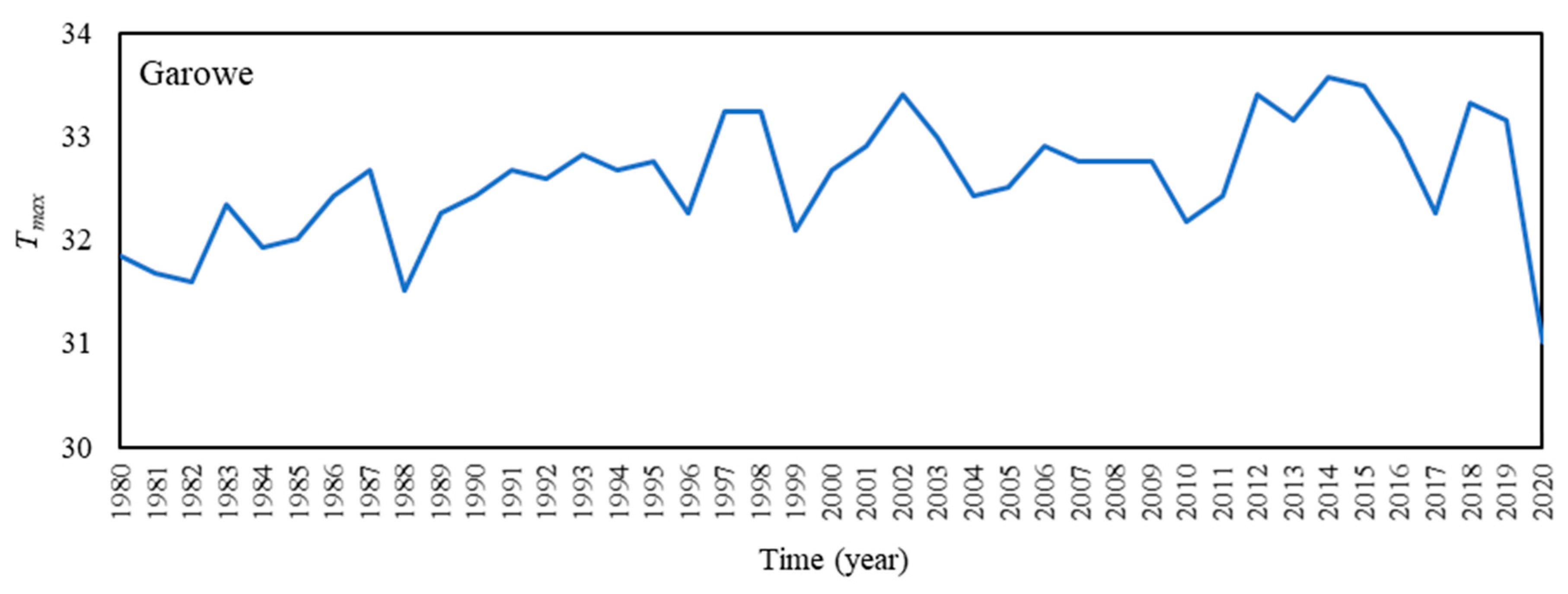
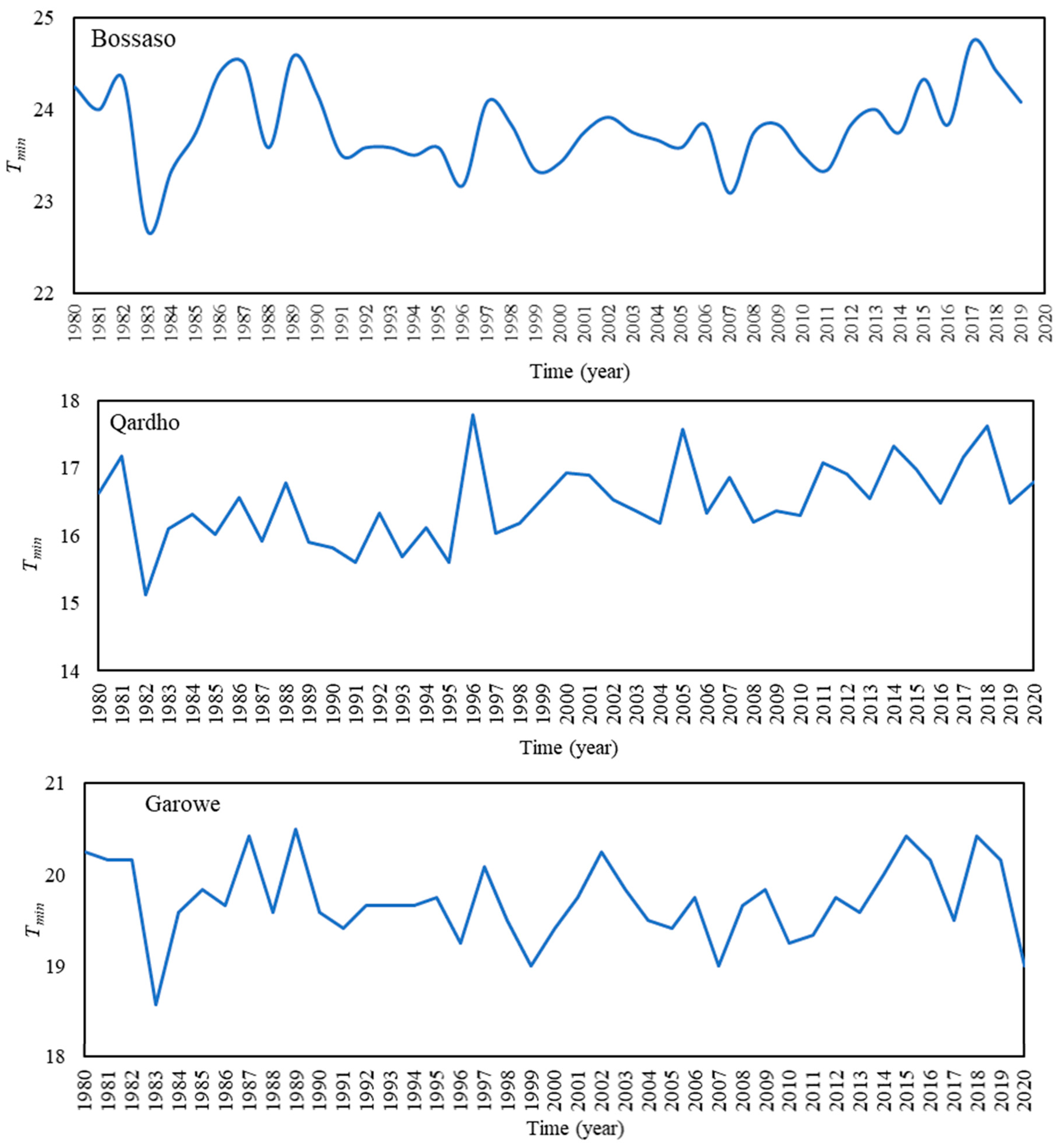
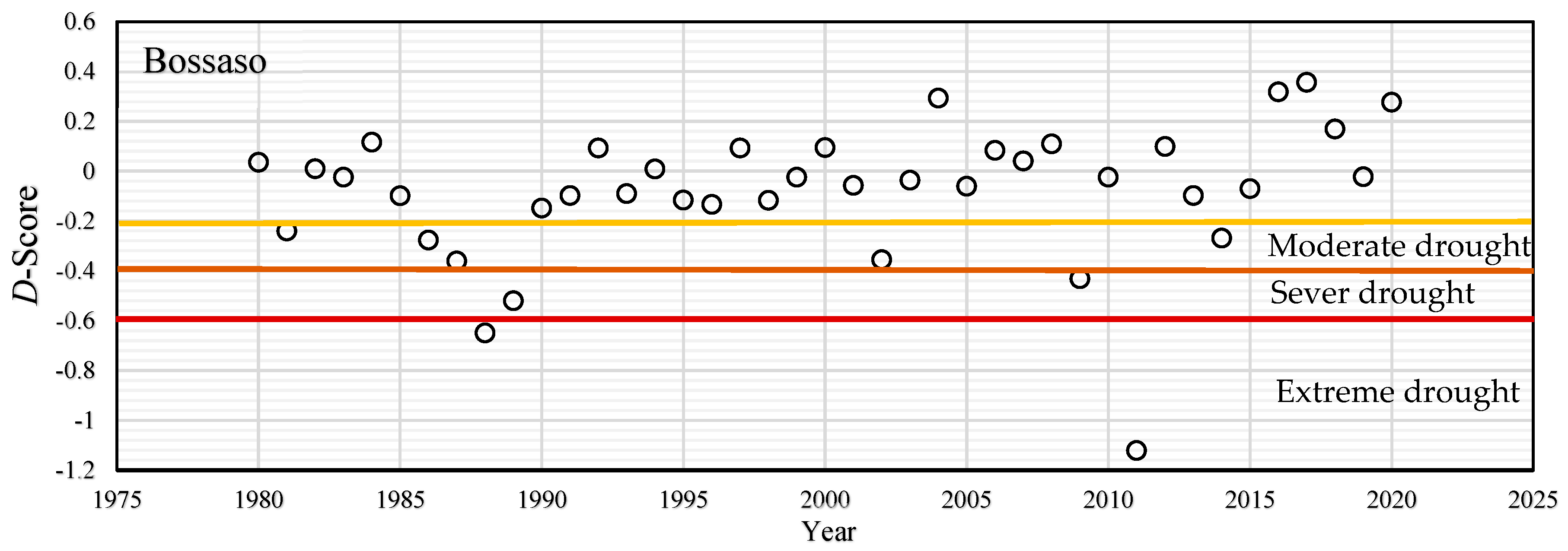


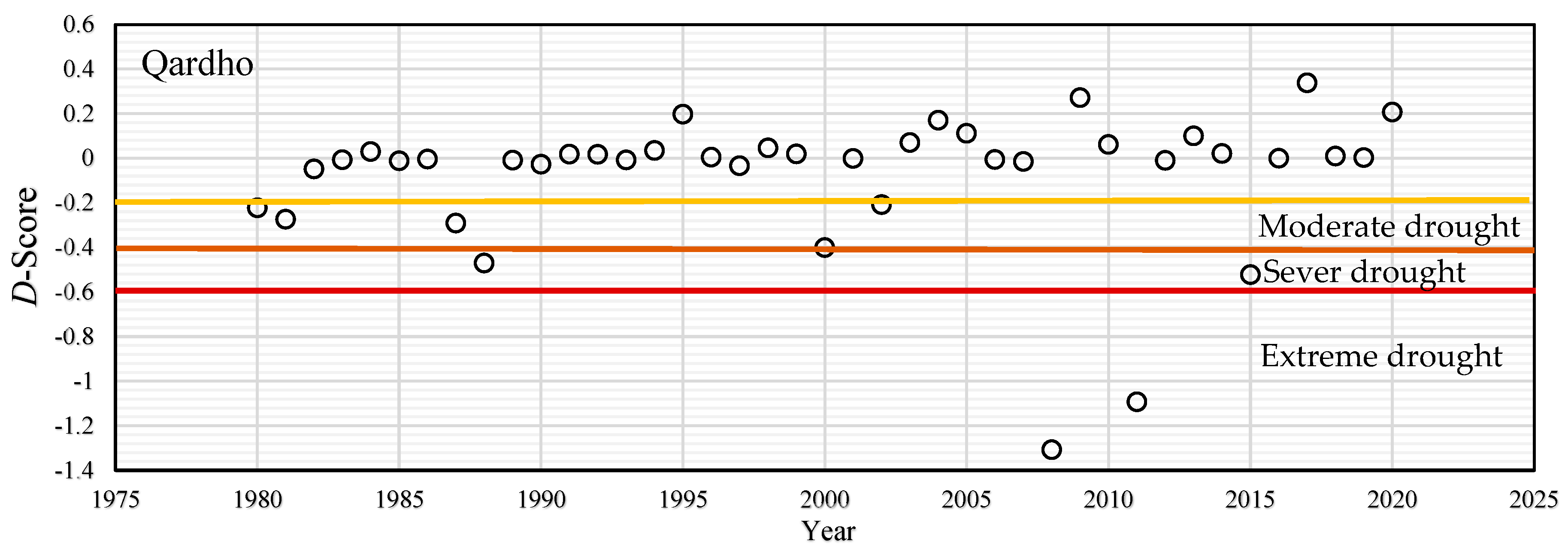
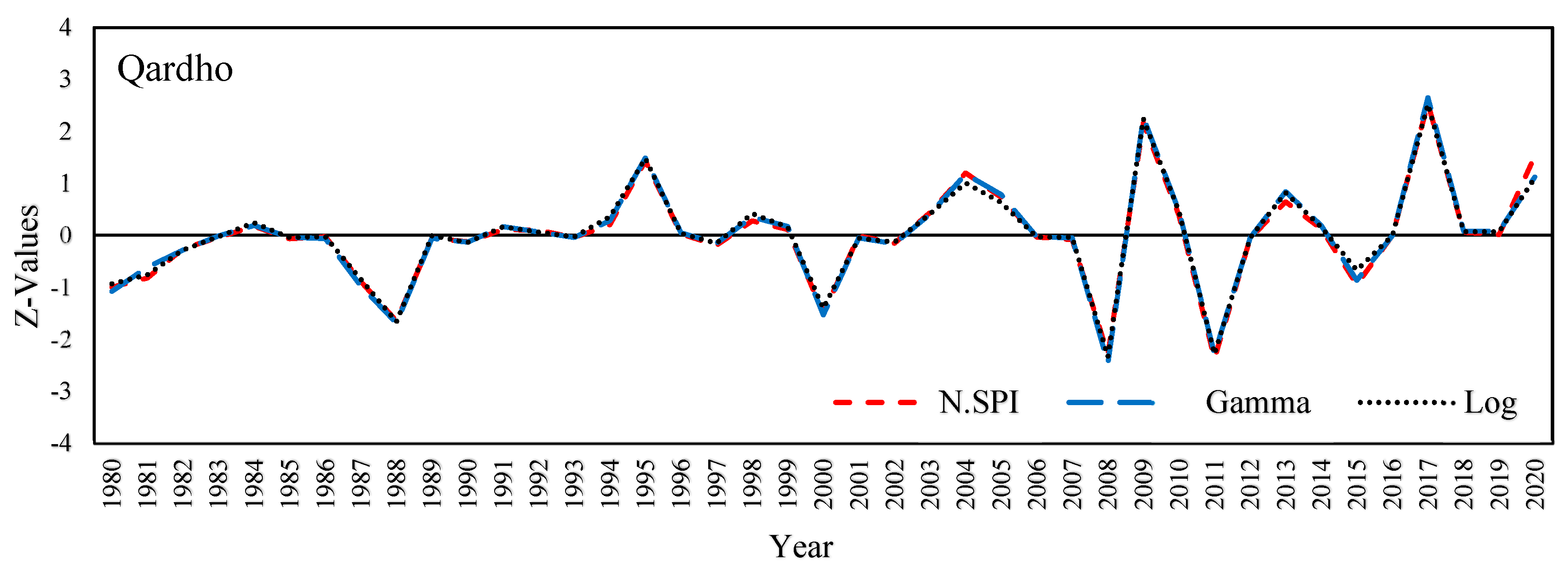


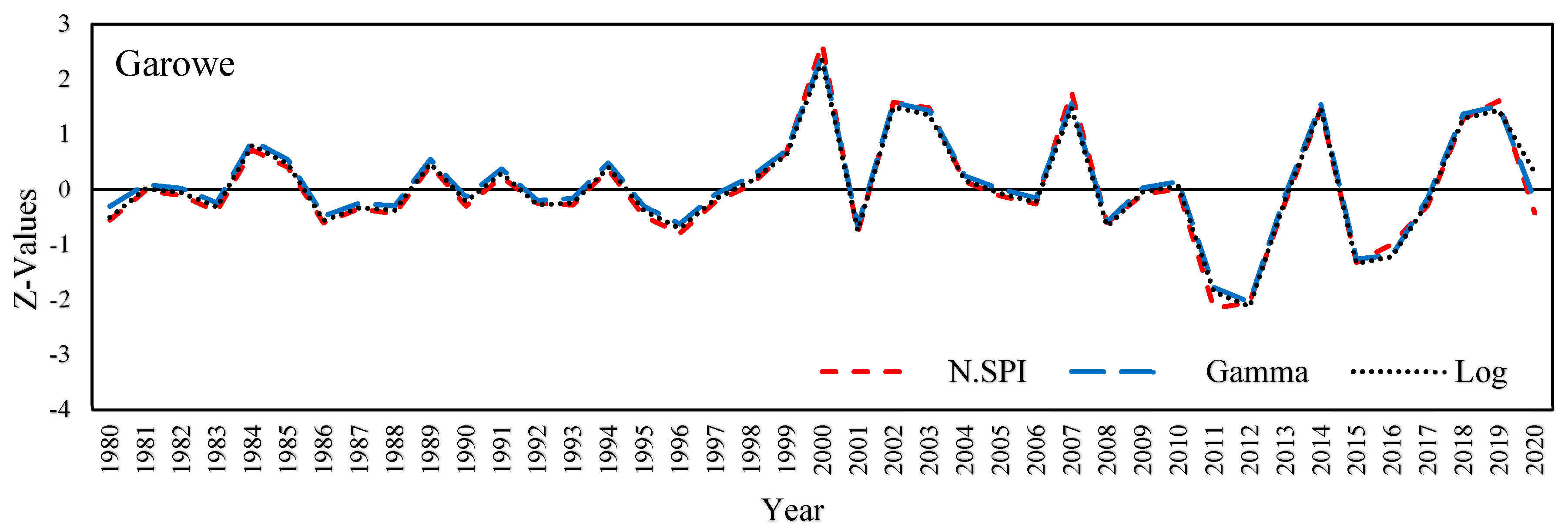

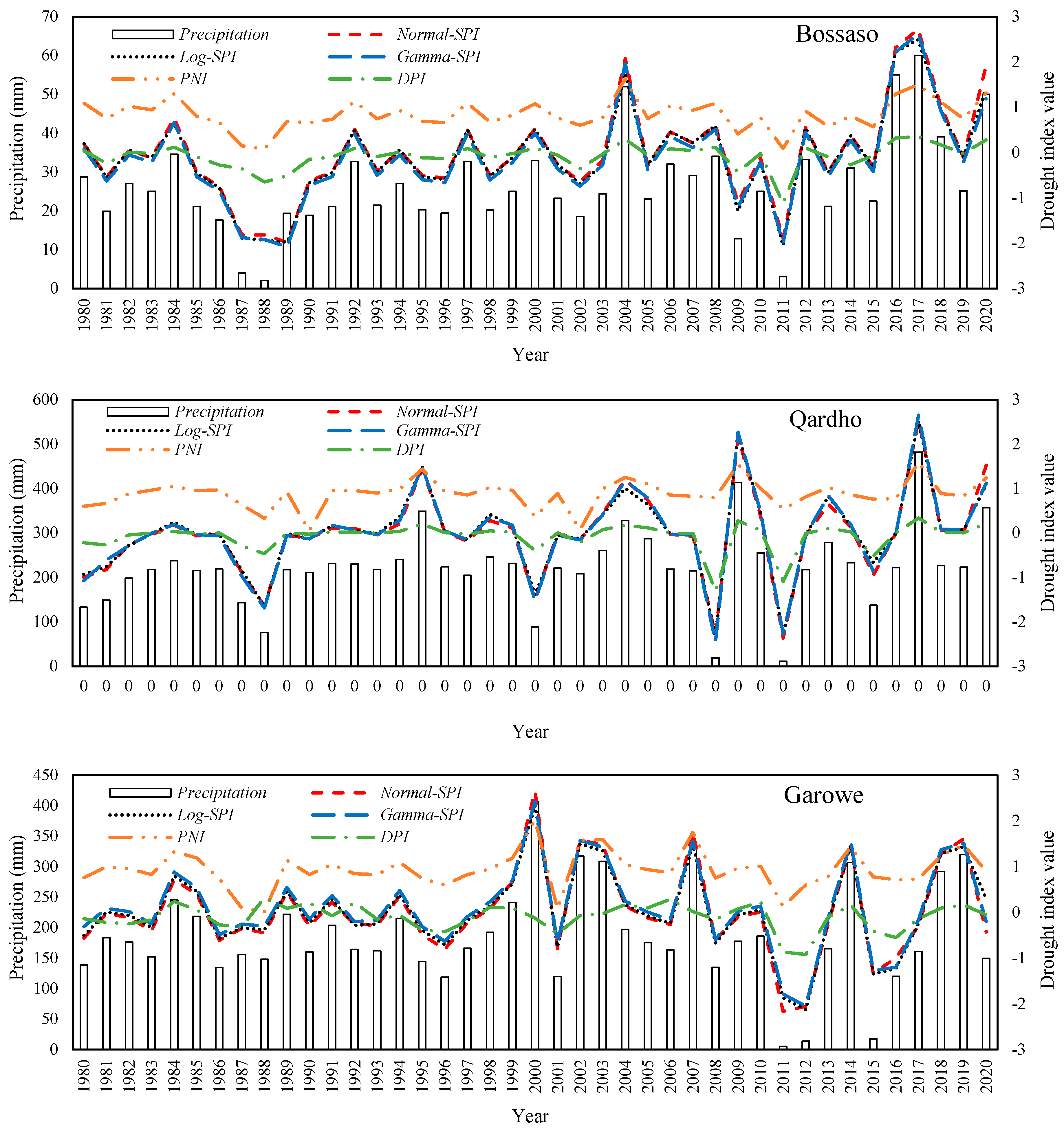
| SPI | Drought Classification |
|---|---|
| ≥2.00 | Extremely wet |
| 1.50 to 1.99 | Very wet |
| 1.00 to1.49 | Moderately wet |
| 0.99 to −0.99 | Near normal |
| −1.00 to −1.49 | Moderately drought |
| −1.50 to −1.99 | Severe drought |
| ≤−2.00 | Extremely drought |
| PNI (%) | Drought Classification |
|---|---|
| ≥100 | Wet |
| 80 to 110 | Normal |
| 55 to 80 | Moderately dry |
| 40 to 55 | Severely dry |
| ≤40 | Extremely dry |
| DPI | Drought Classification | Remark |
|---|---|---|
| 0.0 to −0.19 | Near normal | about 36% more or less than the mean value |
| −0.20 to −0.39 | Moderate drought | about 37–59% less than the mean value |
| −0.40 to −0.59 | Severe drought | about 60–74% less than the mean value |
| ≤−0.60 | Extreme drought | about 75% or more less than the mean value |
| DI | Drought Classification |
|---|---|
| Deciles 1–2 | Lowest 20% much below normal |
| Deciles 3–4 | Next lowest 20% below normal |
| Deciles 5–6 | Middle 20% near normal |
| Deciles 7–8 | Next highest 20% above normal |
| Deciles 9–10 | Highest 20% much above normal |
| Annual Rainfall Values (mm) | Drought Classification |
|---|---|
| 13.8–9.6 | Much below normal |
| 20.7–22.3 | Below normal |
| 25–27 | Near normal |
| 31.4–33.7 | Above normal |
| 48.1–60 | Much above normal |
| Annual Rainfall Values (mm) | Drought Classification |
|---|---|
| 96.9–168.3 | Much below normal |
| 212.6–217.3 | Below normal |
| 220.5–227.1 | Near normal |
| 234.3–258 | Above normal |
| 344.6–481.8 | Much above normal |
| Annual Rainfall Values (mm) | Drought Classification |
|---|---|
| 43.7–136.2 | Much below normal |
| 151–161.4 | Below normal |
| 166–183.7 | Near normal |
| 208–243.4 | Above normal |
| 318.8–406.4 | Much above normal |
| Station | Trend Test Method | SR | MK | Şen | Thiel-Sen | Pettitt’s Test |
|---|---|---|---|---|---|---|
| ZSR | Z | Trend? (+/−) | β (Rate of Increase) per Decade (°C) | Changepoint (Year) | ||
| Bossaso | Tmax | 2.6 | 2.45 | Yes (+) | 0.2 | 2000 |
| Tavg | 5.27 | 4.22 | Yes (+) | 0.3 | 2000 | |
| Tmin | 6.11 | 5.17 | Yes (+) | 0.4 | 2000 | |
| Qardho | Tmax | 1.89 | 1.34 | No (−) | - | - |
| Tavg | 6.02 | 4.77 | Yes (+) | 0.2 | 2000 | |
| Tmin | 7.24 | 5.47 | Yes (+) | 0.3 | 2000 | |
| Garowe | Tmax | 2.71 | 2.52 | Yes (+) | 0.2 | 2000 |
| Tavg | 5.67 | 4.5 | Yes (+) | 0.4 | 2000 | |
| Tmin | 5.15 | 4.29 | Yes (+) | 0.5 | 2000 |
| Station | Trend Test Method | SR | MK | Şen | Thiel-Sen | Pettitt’s Test |
|---|---|---|---|---|---|---|
| ZSR | Z | Trend? (+/−) | β (Rate of Increase) Per Year (mm) | Changepoint (Year) | ||
| Bossaso | 3.43 | 3.12 | Yes (+) | 3.67 | 2000 | |
| Qardho | 1.84 | 1.62 | No (−) | 0.86 | 1998 | |
| Garowe | 3.42 | 2.86 | Yes (+) | 5.41 | 1997 |
| Method | Drought Intensity | Bossaso | Qardho | Garowe |
|---|---|---|---|---|
| Normal-SPI | Extreme | 2011 | 2011 2008 | 2011 2012 |
| Severe | 1988 1889 | 2015 2000 | 2015 2016 | |
| Moderate | 1981 1986 1987 2002 2009 | 1988 1987 | 1986 1987 1995 1996 2001 | |
| Log-SPI, Gamma-SPI | Extreme | 2011 | 2011 2008 | 2011 2012 |
| Severe | 1988 1889 | 2015 2000 | 2015 2016 | |
| Moderate | 2009 1986 1987 1981 2002 | 1988 1987 | 1986 1987 1995 1996 2001 | |
| PNI | Extreme | 2011 | 2011 2008 | 2011 2012 |
| Severe | 1988 1889 | 2015 2000 | 2015 2016 | |
| Moderate | 2009 1986 1987 1981 2002 | 1988 1987 | 1986 1987 1995 1996 2001 | |
| DPI | Extreme | 1988 2011 | 2011 2008 | 2011 2012 |
| Severe | 1889 2009 | 2015 2000 1988 | 1996 2001 2015 2016 | |
| Moderate | 1981 1986 1987 2002 2014 | 1980 1981 1987 2002 | 1982 1986 1987 1995 1996 2001 | |
| DI | Extreme and Severe | 2011 1988 1889 | 2011 2008 2015 2000 | 2011 2012 2015 2016 |
| Normal-SPI | Log-SPI | Gamma-SPI | PNI | DPI | |
|---|---|---|---|---|---|
| Bossaso | |||||
| Normal-SPI | 1 | ||||
| Log-SPI | 0.995 | 1 | |||
| Gamma-SPI | 0.996 | 0.997 | 1 | ||
| PNI | 0.885 | 0.891 | 0.885 | 1 | |
| DPI | 0.868 | 0.888 | 0.869 | 0.872 | 1 |
| Qardho | |||||
| Normal-SPI | 1 | ||||
| Log-SPI | 0.994 | 1 | |||
| Gamma-SPI | 0.995 | 0.998 | 1 | ||
| PNI | 0.750 | 0.750 | 0.749 | 1 | |
| DPI | 0.880 | 0.881 | 0.881 | 0.542 | 1 |
| Garowe | |||||
| Normal-SPI | 1 | ||||
| Log-SPI | 0.988 | 1 | |||
| Gamma-SPI | 0.994 | 0.995 | 1 | ||
| PNI | 0.859 | 0.841 | 0.842 | 1 | |
| DPI | 0.596 | 0.627 | 0.626 | 0.433 | 1 |
| Method | Bossaso | Qardho | Garowe |
|---|---|---|---|
| Period | |||
| Normal-SPI | 1986–1989 | 1987–1988 | 1986–1987 1995–1996 2011–2012 2015–2016 |
| Log-SPI, Gamma-SPI | 1986–1989 | 1987–1988 | 1986–1987 1995–1996 2011–2012 2015–2016 |
| PNI | 1986–1989 | 1987–1988 | 1986–1987 1995–1996 2011–2012 2015–2016 |
| DPI | 1986–1989 | 1980–1981 1987–1988 | 1986–1987 1995–1996 2011–2012 2015–2016 |
| DI | 1988–1989 | 2011–2012 2015–2016 | |
Disclaimer/Publisher’s Note: The statements, opinions and data contained in all publications are solely those of the individual author(s) and contributor(s) and not of MDPI and/or the editor(s). MDPI and/or the editor(s) disclaim responsibility for any injury to people or property resulting from any ideas, methods, instructions or products referred to in the content. |
© 2023 by the authors. Licensee MDPI, Basel, Switzerland. This article is an open access article distributed under the terms and conditions of the Creative Commons Attribution (CC BY) license (https://creativecommons.org/licenses/by/4.0/).
Share and Cite
Muse, N.M.; Tayfur, G.; Safari, M.J.S. Meteorological Drought Assessment and Trend Analysis in Puntland Region of Somalia. Sustainability 2023, 15, 10652. https://doi.org/10.3390/su151310652
Muse NM, Tayfur G, Safari MJS. Meteorological Drought Assessment and Trend Analysis in Puntland Region of Somalia. Sustainability. 2023; 15(13):10652. https://doi.org/10.3390/su151310652
Chicago/Turabian StyleMuse, Nur Mohamed, Gokmen Tayfur, and Mir Jafar Sadegh Safari. 2023. "Meteorological Drought Assessment and Trend Analysis in Puntland Region of Somalia" Sustainability 15, no. 13: 10652. https://doi.org/10.3390/su151310652
APA StyleMuse, N. M., Tayfur, G., & Safari, M. J. S. (2023). Meteorological Drought Assessment and Trend Analysis in Puntland Region of Somalia. Sustainability, 15(13), 10652. https://doi.org/10.3390/su151310652








